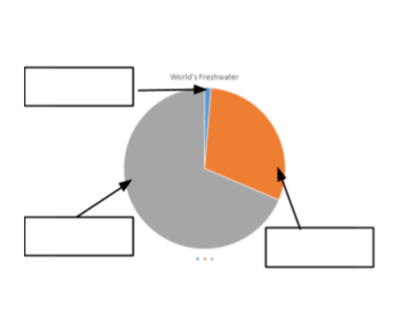An example of interdependence is between plants and humans. Plants provide oxygen to humans so that we can survive, and humans provide carbon dioxide to plants so that they can make their own food.
True
True or false:
Energy from the sun, or solar energy, travels through space to be absorbed by consumers in order for them to create food.
False
Energy from the sun, or solar energy, travels through space to be absorbed by producers in order for them to create food.
True or false:
Without the biosphere or geosphere, there would be no water cycle.
False
Without climate or weather, there would be no water cycle.
True or false:
Heat slows down the process of evaporation.
False
Heat speeds up the process of evaporation.
True or false:
Once made, human footprints can be reduced through careful planning and conservation.
True
What only eats producers?
a. herbivores
b. carnivores
c. omnivores
d. dinosaurs
a. herbivores
A diagram showing the transfer of energy between members of an ecosystem is provided. The information in this diagram supports which of the following ideas?  a. all organisms depend on other organisms for food
a. all organisms depend on other organisms for food
b. every animal gets it energy form another kind of animal
c. all organisms will be eaten by another organism at some time
d. the original source of energy for all organisms is the Sun
d. the original source of energy for all organisms is the Sun
What does this picture show?
Rain shadow effect
What is an area where standing water covers the soil or where the ground is very wet?
a. wetlands
b. rivers
c. lakes
d. streams
a. wetlands
What is "the science, art, and business of cultivating soil, producing crops, and raising livestock"?
a. vegetation
b. agriculture
c. resources
d. community
b. agriculture
Give three examples of important nonliving things in an ecosystem.
Sunlight, water, air, wind, or rocks.
What are the three things that a plant needs to make their own food?
Sunlight, water, and carbon dioxide
What are Earth's four major systems?
1. Atmosphere
2. Hydrosphere
3. Geosphere
4. Biosphere
Label the diagram:
Gray = glaciers and ice caps
Orange = groundwater
Blue = surface water
What is one resource that humans use?
Some examples are wood, oil, water, etc.
Fill in the blank:
An organism depends on its ecosystem to meet its __________.
needs
Fill in the blank:
Energy is used for growth, motion, and to __________, or make the body well again.
Repair
seasonal, temperature, average, weather, generally, yearly
Climate
Where is the majority of freshwater found and why is it unusable?
Most of Earth's freshwater is found in glaciers and ice caps. The freshwater there is unusable because it is frozen and inaccessible.
Fill in the blank:
Wind, solar, geothermal, and hydroelectric are examples of __________ energy.
alternative
Zebra mussels, which are not native to Lake Michigan, compete with the native mussels for food, space, and oxygen, and are reproducing twice as fast as the native mussels. What would you call the Zebra mussels? What do you think will happen to the ecosystem in Lake Michigan as a result?
The Zebra mussels are invasive species. Because the zebra mussels reproduce twice as fast, it would cause an overpopulation of the zebra mussels. The ecosystem will become unbalanced and eventually the native mussels will die out.
How does the energy we get from food relate to the Sun? Give an example of one food that we eat.
The Sun is the energy source for all energy in a food web. For example, we eat salads. The lettuce in the salad we eat is a producer and makes its own food using the energy from the Sun. Without the Sun, we would not have the food we eat.
What is an El Niño and what does it do to the weather in California?
The El Niño is when warm wind from the equator causes the ocean water to be warmer than usual.
California would get more precipitation, meaning heavier rain and snow.
What is desalination and why is it necessary?
Desalination is the process of removing salt and other minerals from ocean water to make it fresh and clean to drink. Humans need to drink freshwater to survive, but there is a limited amount available to us. If we can make ocean water not salty, it would be drinkable.
What is deep lake cooling and how does it work?
Deep lake cooling is an alternative energy source to fossil fuel powered electricity. The system takes cold water from the lake, uses that cold water to cool down some air, and then pumps the cold air into the building. The water is then pumped back to the lake.